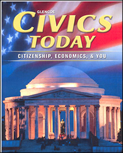Civics Today Citizenship, Economics, & YouChapter 8:
The Judicial BranchWeb Activity Lesson PlansIntroduction
In this chapter students read about the judicial branch of government. Article III of the U.S. Constitution created a national Supreme Court and gave Congress the power to establish lower federal courts. While the Supreme Court holds original jurisdiction over two types of cases, most of its cases are heard on appeal from lower courts. In this activity students will take a closer look at the workings of the Supreme Court.
Lesson Description
In this lesson students will visit the FindLaw Constitutional Law Center's Web site on the Supreme Court. They will review the process by which a case moves through the Court. After answering several questions they will construct an illustrated flow chart depicting this process.
Instructional Objectives- The learner will be able to identify the process by which a case moves through the U.S. Supreme Court.
- The learner will be able to create a flow chart illustrating the movement of a case through the Supreme Court.
Student Web Activity Answers- About 7,000 petitions are presented to the Court each year.
- The Court's law clerks perform the initial screening of the petitions. During the voting process, the Chief Justice votes first, then the associate justices in order of seniority.
- The hypothetical questions are opportunities to pose slightly different factual situations to which a decision may have implications in the future.
- Lawyers receive a white quill pen as a souvenir when they argue a case before the Supreme Court.
- Students' flow charts should reflect information learned from the Web site.
 | 




